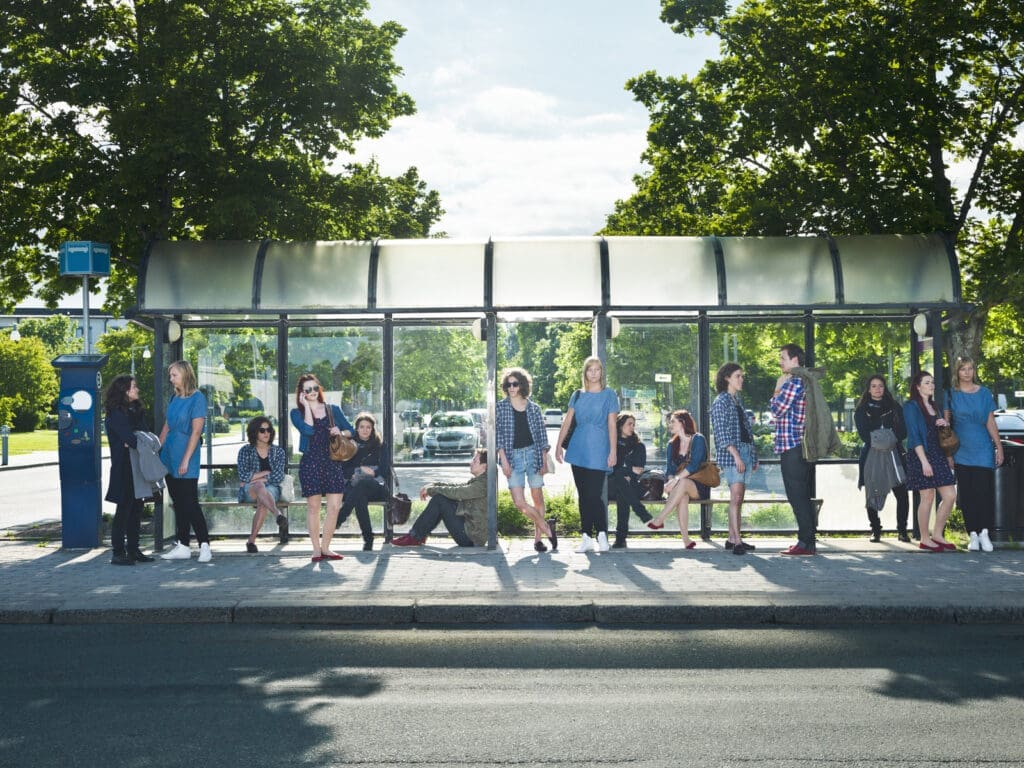Design thinking is a way of solving problems by understanding the needs of users and creating innovative solutions. Sounds complex? Let’s look at an example. You are waiting at a bus stop and you see the people around you frustrated, squirming in their seats, repeatedly getting up and peering into the street to check if the bus is arriving.

How do you solve this problem? Look at the key issues. People are uncomfortable, bored and tired of waiting for a bus that might show up any minute, but seems to take forever to come. If you were to make some changes to the design of the bus system, what would you do?
Maybe, add more comfortable seating. Develop a system for giving real time updates about the whereabouts of the bus, like a Google Maps service for public buses. Also, if you have enough funds, you might even add some entertainment and comfort facilities at bus stops, like drinking water, charging points, magazines and a small TV screen. There you go! You have just glimpsed the world of design thinking.
Understanding design thinking
Design thinking promotes a problem-solving approach and a creative mindset- both are highly sought after qualities in the field of UX design. Design thinking tackles what are often called ‘wicked problems’. These are problems that involve multiple factors that are difficult to define and always fluctuating, like poverty, climate change, ineffective healthcare, education, etc.

Schmiedger and colleagues (2016) have analysed how one can measure the effectiveness of design thinking. In the same year, a survey by Forrester, a research and advisory firm, found that 46% of design led firms consciously put the consumer first, 83% use tools or systems to test ideas with customers, and 86% involve design teams in shaping strategy.
Design thinking starts with gaining a new perspective on these problems; by looking at them from a human centric lens. That means, you ask yourself, “How is this problem affecting the stakeholders? What kind of experience do they want, and how can we get there?” Basically, you focus on understanding the needs, desires and behaviour of the people who will ultimately be affected by the solution.
Key stages of design thinking
Empathy
To empathize with someone is to metaphorically step into shoes, and experience the world from their perspective. Give yourself exposure to the experiences of your clients and stakeholders. For example, if you are trying to modify a website for event registrations, go to the website as a user. Click through different pages and sections, try signing up for an event.
Then ask yourself, how does it feel to be on this website? Does it look appealing, eye-catching, or boring? Is the processing speed fast or slow? Are the options easy to understand, or confusing? How much time does it take for a user to complete the registration?
Define
At this stage, you reflect on your observation to come up with the key deficits or problem areas. What are the core problems? Once you get to the bottom of why a product or service is dissatisfactory, you can start working on ways to modify it.
In the above example, suppose you find that the icon for ‘Register Here’ is the same color as the other icons for more information about the events. As a result, it is not really popping up in the users’ visual field. Moreover, there isn’t enough color contrast between the background color and the color of various icons. Now that you have identified the problems, you can go ahead and modify these features.
Ideate
Design thinkers are encouraged to think outside the box. They look at a problem from different perspectives. Brainstorming with a team is a good idea to come up with possible solutions and getting immediate feedback on their feasibility. For example, flashy colors and blinking icons may seem eye catching, but from the users’ perspective, they could be rather annoying. So, the team could come up with ideas for better color schemes and style the icons in a different way.
Prototype
At this stage, we build a scaled-down, tangible representation of one or more ideas for testing. In this experimental phase, the team can test the reliability and feasibility of different solutions. For example, you can build a prototype of the registrations web page and soft launch it among a select group of users to test it out.
Test
At this stage, the team gathers feedback by testing the prototype with real users to refine and improve the solution. The prototypes are rigorously tested by evaluators to address any flaws or shortcomings that may cause problems in the long term. If you find that the prototype is not good enough, you go back to stage one.
Design thinking is an iterative process, meaning that you repeat a series of steps again and again, tweaking things here and there, improving your product with each cycle. For example, you find that your new color scheme is not really appealing to users, and makes it look more like a healthcare/education website rather than a fun event registration page. Now, you can go back to where you started- talk to users, understand their needs, find a solution, make it happen, and test it out.
Applications of design thinking
Design thinking contributes to the field of healthcare by empathizing with patients, understanding their needs, proposing patient centered solutions to problems, improving healthcare spaces, enhancing flow of communication between doctors and patients, and designing behavioral health and wellness programs.
For example, design thinking teams can brainstorm solutions for promoting healthy diet and exercise habits, or help design programs for smoking cessation. In March 2022, Voorheis and colleagues mapped evidence about integration of behavioral science with design thinking to develop mobile health interventions.

In education, design thinking is applied to reimagine and enhance learning experiences by focusing on the needs and perspectives of students, educators, and other stakeholders. The process begins with empathizing to understand the challenges and aspirations of learners, followed by defining specific educational problems in a human-centric manner.

Ideation involves generating creative solutions to address these challenges, ranging from innovative teaching methods to interactive learning resources. Prototyping allows for the creation and testing of tangible models, such as curriculum prototypes or educational tools, while the testing phase involves gathering feedback from students and educators to refine and improve the educational solutions.
Design thinking in education fosters a collaborative and iterative approach, empowering educators to continuously adapt and innovate their teaching methods, curricula, and learning environments to better meet the evolving needs of students in the 21st century.
To conclude, design thinking is an iterative process that focuses on empathy, creativity and a human centric approach to solving problems. It may be used to solve complex problems in various fields like healthcare, education, web design, business administration, etc.
If you are a strategist, brand designer, or any professional who would benefit from design thinking in their work process, you can use this article as a starting point for learning more about design thinking and how it is applied to real world problems. Put your thinking cap on, good luck!


GIPHY App Key not set. Please check settings